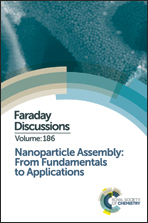Designing disordered materials using DNA-coated colloids of bacteriophage fd and gold†
Abstract
DNA has emerged as an exciting binding agent for programmable colloidal self-assembly. Its popularity derives from its unique properties: it provides highly specific short-ranged interactions and at the same time it acts as a steric stabilizer against non-specific van der Waals and Coulomb interactions. Because complementary DNA strands are linked only via hydrogen bonds, DNA-mediated binding is thermally reversible: it provides an effective attraction that can be switched off by raising the temperature only by a few degrees. In this article we introduce a new binary system made of DNA-functionalized filamentous fd viruses of ∼880 nm length with an aspect ratio of ∼100, and 50 nm gold nanoparticles (gold NPs) coated with the complementary DNA strands. When quenching mixtures below the melt temperature Tm, at which the attraction is switched on, we observe aggregation. Conversely, above Tm the system melts into a homogenous particulate ‘gas’. We present the aggregation behavior of three different gold NP to virus ratios and compare them to a gel made solely of gold NPs. In particular, we have investigated the aggregate structures as a function of cooling rate and determine how they evolve as function of time for given quench depths, employing fluorescence microscopy. Structural information was extracted in the form of an effective structure factor and chord length distributions. Rapid cooling rates lead to open aggregates, while slower controlled cooling rates closer to equilibrium DNA hybridization lead to more fine-stranded gels. Despite the different structures we find that for both cooling rates the quench into the two-phase region leads to initial spinodal decomposition, which becomes arrested. Surprisingly, although the fine-stranded gel is disordered, the overall structure and the corresponding length scale distributions in the system are remarkably reproducible. Such highly porous systems can be developed into new functional materials.
- This article is part of the themed collection: Nanoparticle Assembly: From Fundamentals to Applications

 Please wait while we load your content...
Please wait while we load your content...